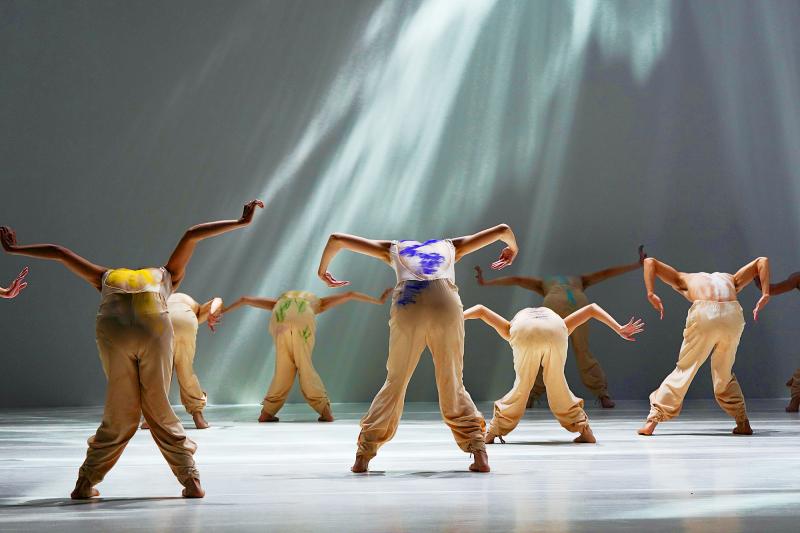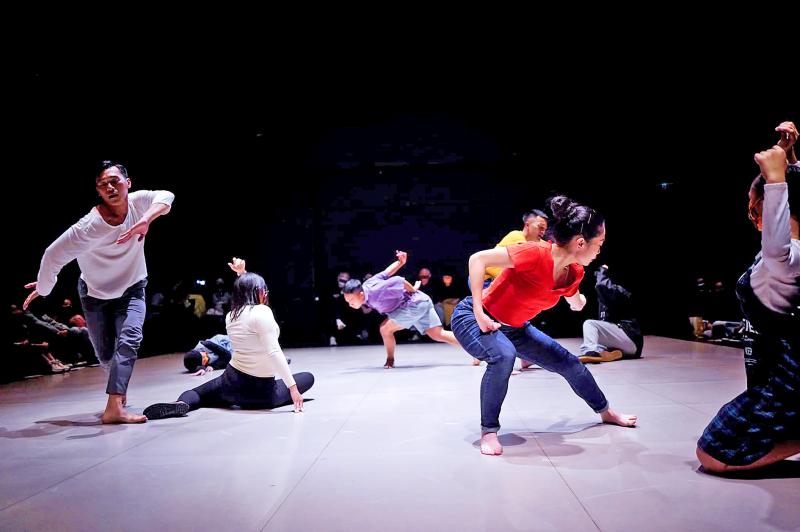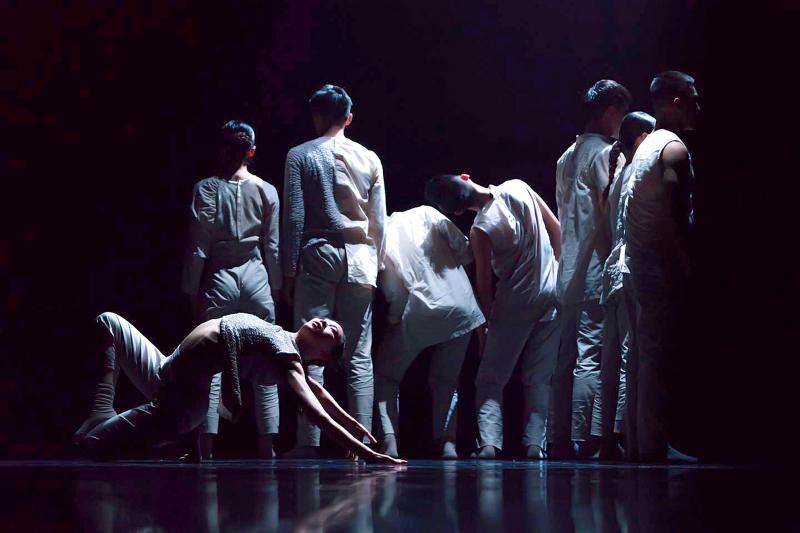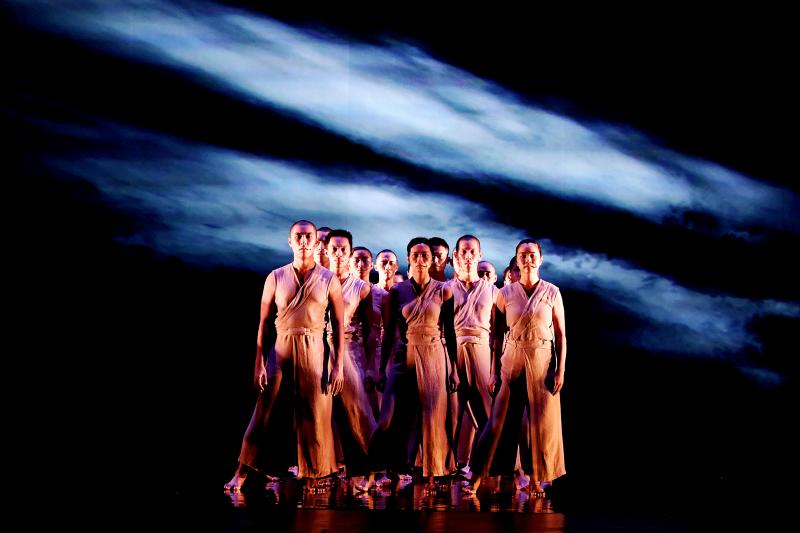In a year when so many theaters and performing arts companies were forced to shutter due to the COVID-19 pandemic, audiences and artists in Taiwan were able to enjoy a relative degree of normality, and I felt ridiculously fortunate to not only be able to see shows, but see so many good ones.
While many productions exceeded expectations, I decided against doing a Top 10 dance list, choosing instead to focus on the development of choreographers and companies shown through their new works or revivals.
However, if there were a list, Cheng Tsung-lun’s (鄭宗龍) Sounding Light (定光), his first full-length work for Cloud Gate Dance Theatre (雲門舞集) as artistic director, would be on top.

Photo: CNA
Sounding Light, which premiered at the National Theater in Taipei on Oct. 1, is deceptively sparse, yet filled with intriguing movement, light patterns and sounds that highlight Cheng’s continuing development of a unique movement vocabulary and stage artistry.
It is also a testament to the depth of talent Cheng has to work with in a reformatted company made up of veterans of Cloud Gate and the now-suspended Cloud Gate 2 (雲門2).
Depth of talent is the hallmark of another company that grew out of Cloud Gate: the Bulareyaung Dance Company (BDC, 布拉瑞揚舞團), whose founder, Bulareyaung Pagarlava (Bula) started his career as a Cloud Gate dancer and became CG2’s first resident choreographer.

Photo courtesy of Tjimur Dance Theatre
He returned to Taitung County in 2014 to establish his own troupe and focus on the development of dancers from indigenous communities, and BDC marked its fifth anniversary this year with LIMA, a weekend sampler of works at the Cloud Gate Theater in New Taipei City.
The sold-out run turned out to be a massive love fest between the company’s multi-talented men, who dance, sing and act with such exuberance, yet still wring tears in the more poignant moments, and their fans.
I caught the first show, Yes or NO (#是否), which was just as good as last year’s premiere, but left me wishing I could have dropped everything else to see the rest of the weekend’s performances.

Photo courtesy of Hung Dance
Two shows by BDC’s older counterpart from Pingtung County, the family-run Tjimur Dance Theatre (蒂摩爾古薪舞集) also stole my heart: a restaging last month of Varhung — Heart to Heart (Varhung — 心事誰人知) at the National Kaohsiung Center for the Arts’ Dance Platform, and their new production, Go Paiwan (去排灣), at the National Experimental Theater in Taipei at the beginning of this month.
For Go Paiwan, artistic director Ljuzem Madiljin for the first time invited a guest choreographer to work with her choreographer brother, Baru Madiljin, to develop a “dance theater” piece.
Lin Wen-chung’s (林文中) contribution help create a show that celebrates the company’s traditional dance and singing strengths while embracing audience participation and smartphone technology. It proved to be terrific fun.

Photo: AFP
Lai Hung-chung (賴翃中) also moved beyond his comfort zone with his latest work for his Hung Dance (翃舞製作) troupe, See You (再 見), which premiered at the Taipei Shuiyuan Theater on Nov. 6.
Set on eight dancers, it is a moving exploration of life and loss, and demonstrates Lai’s ability craft more than the duets and trios that he is known for.
Two revivals that were actually almost complete restagings, while vastly different in size and scope, were knock-outs: U-Theatre’s (優人神鼓) River Journey (與你共舞) at the National Theater last weekend and Taipei Dance Forum’s (舞蹈空間) Red and White, zoom-in (紅與白zoom-in版) by choreographer Cheng Yi-wen (鄭伊雯) and theater director Liu Shou-yao (劉守曜) in September.
Two memorable shows from the Taipei Arts Festival were Berlin-based Singaporean artist Choy Ka-fai’s (徐家輝) CosmicWander: OnGon+NeZha and from Thailand, Pichet Klunchun Dance Company’s No. 60.
And while not a dance production, I cannot end this round-up without mentioning Formosa Circus Art’s (FOCA, 福爾摩沙馬戲團) Moss (苔痕), a collaboration with Germany-based dancer/choreographers Jan Mollmer and Tien Tsai-wei (田采薇).
A combination of circus acrobatics and dance theater, it is an outstanding show about friendship and memories, and a proof of FOCA’s commitment to challenge boundaries and preconceptions.

Nine Taiwanese nervously stand on an observation platform at Tokyo’s Haneda International Airport. It’s 9:20am on March 27, 1968, and they are awaiting the arrival of Liu Wen-ching (柳文卿), who is about to be deported back to Taiwan where he faces possible execution for his independence activities. As he is removed from a minibus, a tenth activist, Dai Tian-chao (戴天昭), jumps out of his hiding place and attacks the immigration officials — the nine other activists in tow — while urging Liu to make a run for it. But he’s pinned to the ground. Amid the commotion, Liu tries to

The slashing of the government’s proposed budget by the two China-aligned parties in the legislature, the Chinese Nationalist Party (KMT) and Taiwan People’s Party (TPP), has apparently resulted in blowback from the US. On the recent junket to US President Donald Trump’s inauguration, KMT legislators reported that they were confronted by US officials and congressmen angered at the cuts to the defense budget. The United Daily News (UDN), the longtime KMT party paper, now KMT-aligned media, responded to US anger by blaming the foreign media. Its regular column, the Cold Eye Collection (冷眼集), attacked the international media last month in

Feb. 10 to Feb. 16 More than three decades after penning the iconic High Green Mountains (高山青), a frail Teng Yu-ping (鄧禹平) finally visited the verdant peaks and blue streams of Alishan described in the lyrics. Often mistaken as an indigenous folk song, it was actually created in 1949 by Chinese filmmakers while shooting a scene for the movie Happenings in Alishan (阿里山風雲) in Taipei’s Beitou District (北投), recounts director Chang Ying (張英) in the 1999 book, Chang Ying’s Contributions to Taiwanese Cinema and Theater (打鑼三響包得行: 張英對台灣影劇的貢獻). The team was meant to return to China after filming, but

On a misty evening in August 1990, two men hiking on the moors surrounding Calvine, a pretty hamlet in Perth and Kinross, claimed to have seen a giant diamond-shaped aircraft flying above them. It apparently had no clear means of propulsion and left no smoke plume; it was silent and static, as if frozen in time. Terrified, they hit the ground and scrambled for cover behind a tree. Then a Harrier fighter jet roared into view, circling the diamond as if sizing it up for a scuffle. One of the men snapped a series of photographs just before the bizarre